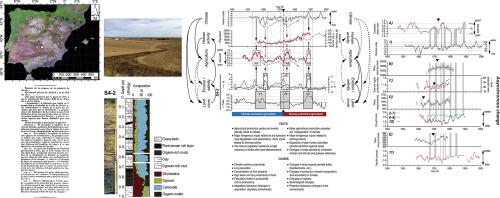当前位置:
X-MOL 学术
›
Palaeogeogr. Palaeoclimatol. Palaeoecol.
›
论文详情
Our official English website, www.x-mol.net, welcomes your
feedback! (Note: you will need to create a separate account there.)
The transition from climate-driven to human-driven agriculture during the Little Ice Age in Central Spain: Documentary and fluvial records evidence
Palaeogeography, Palaeoclimatology, Palaeoecology ( IF 2.6 ) Pub Date : 2021-01-01 , DOI: 10.1016/j.palaeo.2020.110153 Juan I. Santisteban , Alberto Celis , Rosa Mediavilla , Mª. José Gil-García , Blanca Ruiz-Zapata , Silvino Castaño
Palaeogeography, Palaeoclimatology, Palaeoecology ( IF 2.6 ) Pub Date : 2021-01-01 , DOI: 10.1016/j.palaeo.2020.110153 Juan I. Santisteban , Alberto Celis , Rosa Mediavilla , Mª. José Gil-García , Blanca Ruiz-Zapata , Silvino Castaño

|
Abstract Knowledge about the relative impact of climate and socio-economic factors on agriculture is still not well known as they change in space and time. Social researchers stress the role of endogenous (societal, economical, etc.) factors whilst physical/natural scientists focus on the role of climate on land use and land cover change, but the latter do not usually focus on human dynamics. Through the analysis of proxies of land cover, sediment yield (erosion) and salinity changes from sediments in a fluvial wetland in central Spain and documentary evidence collected from the 16th century onwards, it becomes clear that climate impact on farming has changed during this period. Thus, until ca. 1725 CE, agriculture production in central-southern Spain followed the cycles and trends of rainfall at the annual, multiannual and decennial time scales. From that time onwards, production began to show discrepancies with climate, with high production cycles associated with dry periods being common and a sustained productivity that was independent of climate trends and it must be related to socio-economic changes. This change from climate-driven to human-driven agriculture can be seen in other areas of the Iberian Peninsula but at different times that vary from the first half of the 17th century until the first half of the 18th century. These different times can be attributed to diachronous changes in the Little Ice Age phases and local and regional differences in economic factors (such as proximity to commercial routes, development of markets) and their evolution, as supported by the different information sources.
中文翻译:

西班牙中部小冰河时期从气候驱动到人类驱动农业的转变:纪录片和河流记录证据
摘要 关于气候和社会经济因素对农业的相对影响的知识仍然不为人所知,因为它们会随着空间和时间发生变化。社会研究人员强调内生(社会、经济等)因素的作用,而物理/自然科学家则关注气候对土地利用和土地覆盖变化的作用,但后者通常不关注人类动态。通过对西班牙中部河流湿地沉积物的土地覆盖、沉积物产量(侵蚀)和盐度变化的代理分析以及从 16 世纪以来收集的文献证据,很明显气候对农业的影响在此期间发生了变化。因此,直到大约。公元 1725 年,西班牙中南部的农业生产遵循年、多年和十年时间尺度的降雨周期和趋势。从那时起,生产开始表现出与气候的差异,与干旱期相关的高生产周期很常见,而且持续的生产力与气候趋势无关,而且必须与社会经济变化有关。这种从气候驱动到人类驱动农业的变化在伊比利亚半岛的其他地区也可以看到,但在 17 世纪上半叶到 18 世纪上半叶的不同时期有所不同。这些不同的时间可以归因于小冰河时代阶段的历时变化以及经济因素(例如靠近商业路线、市场发展)及其演变的地方和区域差异,并得到不同信息来源的支持。与干旱期相关的高生产周期很常见,而且持续的生产力不受气候趋势的影响,而且必须与社会经济变化有关。这种从气候驱动到人类驱动农业的变化在伊比利亚半岛的其他地区也可以看到,但在 17 世纪上半叶到 18 世纪上半叶的不同时期有所不同。这些不同的时间可以归因于小冰河时代阶段的历时变化以及经济因素(例如靠近商业路线、市场发展)及其演变的地方和区域差异,并得到不同信息来源的支持。与干旱期相关的高生产周期很常见,而且持续的生产力不受气候趋势的影响,而且必须与社会经济变化有关。这种从气候驱动到人类驱动农业的变化在伊比利亚半岛的其他地区也可以看到,但在 17 世纪上半叶到 18 世纪上半叶的不同时期有所不同。这些不同的时间可以归因于小冰河时代阶段的历时变化以及经济因素(例如靠近商业路线、市场发展)及其演变的地方和区域差异,并得到不同信息来源的支持。
更新日期:2021-01-01
中文翻译:

西班牙中部小冰河时期从气候驱动到人类驱动农业的转变:纪录片和河流记录证据
摘要 关于气候和社会经济因素对农业的相对影响的知识仍然不为人所知,因为它们会随着空间和时间发生变化。社会研究人员强调内生(社会、经济等)因素的作用,而物理/自然科学家则关注气候对土地利用和土地覆盖变化的作用,但后者通常不关注人类动态。通过对西班牙中部河流湿地沉积物的土地覆盖、沉积物产量(侵蚀)和盐度变化的代理分析以及从 16 世纪以来收集的文献证据,很明显气候对农业的影响在此期间发生了变化。因此,直到大约。公元 1725 年,西班牙中南部的农业生产遵循年、多年和十年时间尺度的降雨周期和趋势。从那时起,生产开始表现出与气候的差异,与干旱期相关的高生产周期很常见,而且持续的生产力与气候趋势无关,而且必须与社会经济变化有关。这种从气候驱动到人类驱动农业的变化在伊比利亚半岛的其他地区也可以看到,但在 17 世纪上半叶到 18 世纪上半叶的不同时期有所不同。这些不同的时间可以归因于小冰河时代阶段的历时变化以及经济因素(例如靠近商业路线、市场发展)及其演变的地方和区域差异,并得到不同信息来源的支持。与干旱期相关的高生产周期很常见,而且持续的生产力不受气候趋势的影响,而且必须与社会经济变化有关。这种从气候驱动到人类驱动农业的变化在伊比利亚半岛的其他地区也可以看到,但在 17 世纪上半叶到 18 世纪上半叶的不同时期有所不同。这些不同的时间可以归因于小冰河时代阶段的历时变化以及经济因素(例如靠近商业路线、市场发展)及其演变的地方和区域差异,并得到不同信息来源的支持。与干旱期相关的高生产周期很常见,而且持续的生产力不受气候趋势的影响,而且必须与社会经济变化有关。这种从气候驱动到人类驱动农业的变化在伊比利亚半岛的其他地区也可以看到,但在 17 世纪上半叶到 18 世纪上半叶的不同时期有所不同。这些不同的时间可以归因于小冰河时代阶段的历时变化以及经济因素(例如靠近商业路线、市场发展)及其演变的地方和区域差异,并得到不同信息来源的支持。











































 京公网安备 11010802027423号
京公网安备 11010802027423号